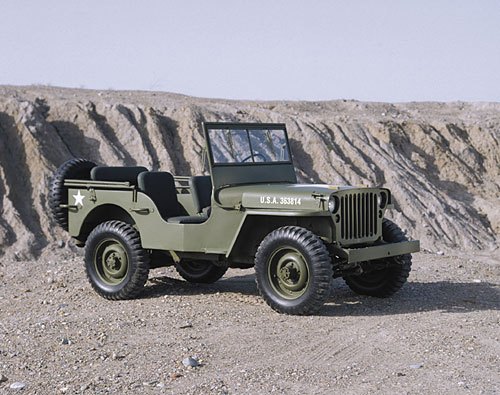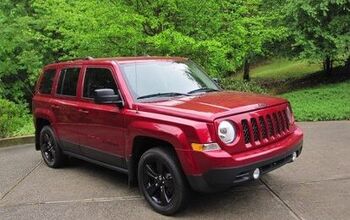In Defense of . . . The Jeep Jinx
I’m a Jeep owner, a Jeep historian and a Jeep enthusiast. I’ve published more than a dozen Jeep articles. I’ve attended dozens of Jeep Jamborees and Camp Jeep events. I’ve driven a Jeep down the Rubicon Trail from start to finish, twice. So it pains me to write about the Jeep Jinx. But the facts are inarguable: virtually every company that’s owned the Jeep brand has fallen on hard times.
The original Jeep prototype was designed and built by a small company called American Bantam. The vehicle’s tendency to be both a curse and a blessing was assured from the start; the U.S. military liked it so much it they shoved Bantam aside. They commissioned competitors Willys-Overland and Ford to more or less copy the design.
In terms of perfecting the vehicle (including better torque), Willys-Overland did most of the heavy lifting. Not surprisingly, the feds gave Ford the nod for organizing mass production. Working together, the two automakers built some 600,000 examples.
After World War II, Ford got out of the Jeep-building business. Willys Motors produced the first civilian Jeep, the CJ-2A, on July 17, 1945. After a slow start (1824 units), sales of the farm-friendly vehicle took off. Willys manufactured the Jeep CJ-2A until 1949, racking up 214,202 sales.
The automaker replaced it with the CJ-3A. But agricultural sales dried up, as farmers turned to tractors. It was not the first time—nor the last–that Jeep found a market pulled out from under its feet, putting its corporate owners in financial jeopardy.
By 1953, Willys-Overland was struggling for survival. The ailing Kaiser-Frazer Corporation decided to buy Willys-Overland, ditch its own car business and produce Jeeps. The reconstituted Willys Motors, Incorporated was born.
In 1963, Willys became Kaiser-Jeep. Looking for new civilian markets, the company introduced the Wagoneer, the precursor to the modern SUV. While the recreational vehicle marketplace experienced sustained growth throughout the sixties, Kaiser-Jeep continued to lose money.
In 1970, American Motors (AMC)—who had its own bout with bankruptcy in 1967—purchased Kaiser’s Jeep operations. In spite of two oil crunches in the seventies, Jeep experienced rapid growth under AMC’s management. The market for dual-purpose vehicles expanded dramatically.
Unfortunately, AMC’s car-making operations were not competitive. Renault partnered with the troubled automaker, then seized control. As the eighties progressed, Renault fell on hard times. Sales of Renault-engineered small cars failed in the US market. The state-owned company also faced political difficulties in its home market.
Renault soon sold its stake in AMC to Chrysler, whose charismatic CEO Lee Iacocca coveted the Jeep brand. In 1987, AMC “merged” with Chrysler. In reality, Jeep was absorbed by Chrysler. This was no bad thing. Chrysler experienced one of the most-sustained growth periods in its history. The rising tide lifted all Jeeps.
This growth period was highly profitable for Chrysler, and Jeep. In 1992, Chrysler debuted the hugely successful Grand Cherokee, an AMC design. The American automaker’s success made it an attractive acquisition target for Daimler, who saw expansion as a way to avoid an unfriendly takeover. At the same time, Chrysler’s executives considered it an opportune time to “cash in their chips.”
And thus the now notorious “merger of equals” with Germany’s Daimler-Benz in 1998, forming DaimlerChrysler. DaimlerChrysler eventually sold most of its interest in Chrysler to Cerberus in 2007—even as Jeep produced some of the least worthy vehicles to ever wear the famous badge.
Two years later, Cerberus lost the rest of its stake as Chrysler descended into C11. With the fed’s help, Italy’s Fiat is pickng-up the pieces. To recap . . .
– Willys – Defunct, sold Jeep to Kaiser in 1953
Jeep is one of the world’s best-known brands. It was one of the pioneers of the sport utility category. Over the years, especially under Chrysler’s stewardship, Jeep sold millions of vehicles. The Wrangler is a worldwide icon. Until recently, the Grand Cherokee was a best-selling SUV, that sold 300,000 units annually.
But it core strength—go-anywhere capability—has always been its weakness. In other words, whether serving the military, farm owners, off-road enthusiasts or Soccer Moms, Jeep is a niche brand. As recent history has shown (e.g., Aston Martin, Jaguar, Land Rover, Saab, HUMMER, Volvo, etc.), large companies and niche brands make terrible bedfellows. Big companies seek volume above all; a tendency that tends to kill the goose that lays the golden eggs.
In fact, you could say that Jeep’s owners have been a jinx on Jeep. With Fiat eyeing Jeep as a way to help it grow to the size it thinks it needs to survive, one gets the distinct impression that bad things are about to happen. Again. Will Fiat be the company that ultimately breaks the Jeep Jinx?
[Read more of Rich Truedell’s work at automotivetraveler.com]
More by Rich Truesdell
Latest Car Reviews
Read moreLatest Product Reviews
Read moreRecent Comments
- Redapple2 Love the wheels
- Redapple2 Good luck to them. They used to make great cars. 510. 240Z, Sentra SE-R. Maxima. Frontier.
- Joe65688619 Under Ghosn they went through the same short-term bottom-line thinking that GM did in the 80s/90s, and they have not recovered say, to their heyday in the 50s and 60s in terms of market share and innovation. Poor design decisions (a CVT in their front-wheel drive "4-Door Sports Car", model overlap in a poorly performing segment (they never needed the Altima AND the Maxima...what they needed was one vehicle with different drivetrain, including hybrid, to compete with the Accord/Camry, and decontenting their vehicles: My 2012 QX56 (I know, not a Nissan, but the same holds for the Armada) had power rear windows in the cargo area that could vent, a glass hatch on the back door that could be opened separate from the whole liftgate (in such a tall vehicle, kinda essential if you have it in a garage and want to load the trunk without having to open the garage door to make room for the lift gate), a nice driver's side folding armrest, and a few other quality-of-life details absent from my 2018 QX80. In a competitive market this attention to detai is can be the differentiator that sell cars. Now they are caught in the middle of the market, competing more with Hyundai and Kia and selling discounted vehicles near the same price points, but losing money on them. They invested also invested a lot in niche platforms. The Leaf was one of the first full EVs, but never really evolved. They misjudged the market - luxury EVs are selling, small budget models not so much. Variable compression engines offering little in terms of real-world power or tech, let a lot of complexity that is leading to higher failure rates. Aside from the Z and GT-R (low volume models), not much forced induction (whether your a fan or not, look at what Honda did with the CR-V and Acura RDX - same chassis, slap a turbo on it, make it nicer inside, and now you can sell it as a semi-premium brand with higher markup). That said, I do believe they retain the technical and engineering capability to do far better. About time management realized they need to make smarter investments and understand their markets better.
- Kwik_Shift_Pro4X Off-road fluff on vehicles that should not be off road needs to die.
- Kwik_Shift_Pro4X Saw this posted on social media; “Just bought a 2023 Tundra with the 14" screen. Let my son borrow it for the afternoon, he connected his phone to listen to his iTunes.The next day my insurance company raised my rates and added my son to my policy. The email said that a private company showed that my son drove the vehicle. He already had his own vehicle that he was insuring.My insurance company demanded he give all his insurance info and some private info for proof. He declined for privacy reasons and my insurance cancelled my policy.These new vehicles with their tech are on condition that we give up our privacy to enter their world. It's not worth it people.”







































Comments
Join the conversation
Hotchkiss of France (Of machine gun fame, and founded by an American) also produced Jeeps, and is now defunct, have been absorbed/merged by other firms. On the other hand, Mahindra and Mihindra of India also produced Jeeps under license, and as far as I know is still making Jeep like vehicles (sans license I believe) and doing fairly well. Edit - Slow_Joe_Crow : You beat me to it while I was typing.
I checked out the "$25 Jeep" rumors in the 70s. It was semi-true. More like $100 on up, but only in lots of 500 or more, if I remember correctly. And no guarantees that they ran or were even complete.